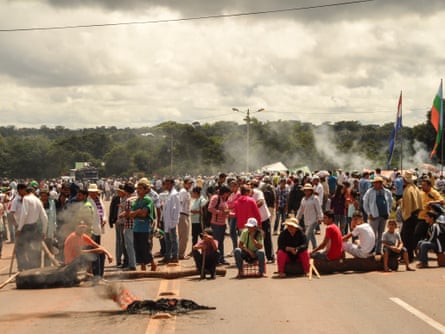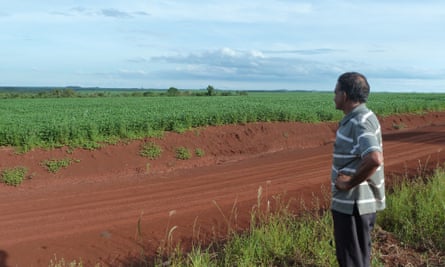Torrential flooding had turned the roads into river and reduced bridges to rubble. We had travelled all the way to Caaguazú in eastern Paraguay to meet some of the farmers suffering the effects of the explosion in global demand for soy, and now even the weather was against us.
But the local NGOs were utterly determined to get us out to the farms. We found a new Jeep and an amazing driver to get us out of holes and along roads, and somehow we were underway.
Key highlights along our route were mostly sad ones. Soy was fast approaching total control in this region. This wonder bean produces fabulous protein and oil and has the remarkable ability to produce its own fertilisers via hosting nitrogen fixing bacteria in its roots. However, global demand for cheap meat fed on soya and grain has exploded. As a result soya – usually genetically engineered to allow herbicide spraying on the whole crop – has taken over major agricultural and forested areas, especially in South America.
In 2006, soy production covered about 1.6m hectares. But by 2013 it was around 3.5m hectares. Exports have nearly doubled since 2006 and the impacts vary from huge biodiversity loss and pollution to urban desertification and political unrest. Eastern Paraguay held much of the once vast and diverse Atlantic forest, home to about 8,000 unique plant species, but in Paraguay just 10% of its original area remains in increasingly isolated fragments. Paraguay’s cities have swelled as a result of migration from rural areas and the remaining farming communities are in constant battles with both the government and big land owners.
Along the route we saw the ugly spread of soya fields next to a street of houses – the trees had been uprooted only recently and as we started to take photos, the family who lived opposite came to chat. They said that Brazilian farmers who had been expanding into Paraguay were clearing the land. Often these new land renters would take the best trees for timber and burn the rest. Enterprising locals sometimes managed to get the leftover logs left to make charcoal in beautiful charcoal burners, which they then sold in local markets.
We went 30km on into the south and followed a dirt track to visit two amazing small farmers, Sixto Alado and Victorino Gimenes Roa. The trees around Victorino’s house (built by Victorino himself) were filled with pineapples, oranges, melons and peanuts. Behind the house was deep forest. We walked into it and the journey was an eye opener. It was a nature-friendly way to live and work; such a biodiverse rich area, an agroforestry paradise with plantings of nuts, multi-cropped with fruit and cassava.

These two amazing small farmers are part of a growing community of farmers resisting the spread of soy farming, and are willing to speak out against the plantations. Chemical contamination and abstraction of water sources is a huge threat to their hugely productive and diverse agroforestry systems. Both Sixto and Victrino spoke of the way they believed diversity way key to feeding people and staying on the land.
“Our farms and our families work together – we want to work and to thrive and be healthy – and that means protecting the trees and the soil and the water. Without that we have nothing. Soy gives nothing and loses everything”
We had to race back to Asuncion to avoid being trapped the wrong side of a blockade. Farmers were protesting their treatment by the government – from bad water management to poor marketing advice leaving them in debt. They argue that they are the victims of unfair treatment by a government keen on helping big agriculture corporations such as Cargill and Monsanto, but less keen to support small farmers against massive market volatility or climate change impacts.

Beef and new soy expansion in the Chaco is one of the most pressing problems. The Chaco is a 250,000-square-mile area in the north, which is 60% of Paraguay’s land area, with some of the highest temperatures in the world and some of the most meagre rainfall. The Chaco contains some vital arid forest and several remote communities. It’s so dry there that extensive beef farming has been the only large scale farming undertaken, and has been the main driver of forest and community destruction over the last two decades as exports have driven massive expansion. The Chaco is currently witnessing some of the world’s most alarming deforestation rates – the latest statistics for September 2014 recorded a loss of 707 hectares per day in the Paraguayan part of the Chaco from beef ranching in lands owned by Ayoreo indigenous tribes, while government departments declare themselves powerless to stop it.
A few days later I was lucky to travel six hours east to meet Geronimo Arevalos – a small farmer increasingly surrounded by soy fields coming as close as 100mfrom his organic holding in the municipality of Minga Porá. He is part of a regional association of small producers resisting the call to sell up, even though many neighbours have given up and gone. He spoke of how for him “the land is life… if no land for food where would I go?”

His tomato crops often wither as they react badly to the herbicides spread by plane over the nearby soy fields. He describes how the local amenities go as the soy farms spread as they need so few staff. Large-scale mechanised agriculture uses far less labour per hectare than small-scale farming techniques, which are typically five-10 hectares. A typical soy farm needs just one worker per 480 hectares compared with the many families on hundreds of holdings there previously. As a result shops, chemists and schools closed, as there are not enough people using them to stay viable. Whole communities end up migrating to the big cities. Arevalos spoke of 25 families who had recently left a nearby area.
There are also health impacts from the pesticides sprayed up to 30 times a year on the crops. The health impacts – Arevalos described spontaneous abortions, skin lesions and stomach problems – were being tracked, but medical recording was all stopped when the coup happened in 2012.
What struck me about the chain of events that had led to his neighbours being forced off the land was how fast a strong resilient diverse farming system was being turned into an export-focused machine. Farmers were promised much by soy company representatives, huge riches compared with the small returns from their manioc fields. But after five years they were in debt and had to sell and leave for the rapidly-growing urban sprawl. Just five years and it’s all gone.
But for Arevalos, the land is life “because you need food and land is food”. He says: “I can’t stop fighting as it will end with mass migration from the area, contamination and destruction of the community”.
Friends of the Earth’s work in Paraguay
In a small municipality in eastern Paraguay called La Pastora, we’ve worked with community groups over a number of years to create and implement a land use plan, an innovative piece of legislation that’s been approved at national and municipal level which protects the area’s environment and small family farms.
La Pastora’s example has been so successful, it’s inspiring other communities across the country. One such is Carmelo Peralta, strategically located on the banks of the river Paraguay which forms part of the northern border with Brazil. Carmelo Peralta covers a huge area, including tropical wetlands of the Pantanal, and is a gateway to the Chaco. In fact, it’s the likely location of a proposed bridge with Brazil, which will open up the area to yet more exploitation. Negotiations have been taking place for months between the municipality and Friends of the Earth Paraguay, and finally, last month they signed an agreement with local stakeholders to develop a land use plan for Carmelo Peralta. This might sound dull, but its significance shouldn’t be underestimated.
What it means is we’re one step closer to creating a shared and sustainable vision for their territory. This could make a huge difference in protecting the environment and the vulnerable from the worst excesses of big business and that sought after foreign investment.
Sitting together on our final day in Asuncion, the group of global forest and environmental campaigners – gathered together by the excellent Global Forest Coalition – agreed to do more. We will see work on an emerging international alliance on unsustainable livestock and feed production and will help the individuals, communities and groups fight for their rights when needed.
Vicki Hird is a senior campaigner at Friends of the Earth. Follow @vickihird on Twitter.
Join our community of development professionals and humanitarians. Follow@GuardianGDP on Twitter.

Comments (…)
Sign in or create your Guardian account to join the discussion